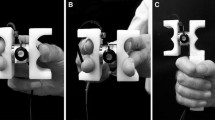Abstract
The time course of changes in the hand muscle activity and the grip force before the hit of an object falling from different heights into a cup held between the thumb and the forefinger was analyzed in three variants of the experiment: (1) the subject saw the object falling; (2) the subject did not see the object falling but initiated the fall; and (3) the subject had no information on either the falling or its start. In the third variant, the muscle activity and the grip force changed in response to the object hitting the cup. In the second variant, the muscle activity and the grip force began to change 200–280 ms before the hit, this time being independent of height from which the object fell. In the first variant, the anticipatory changes began 150 ms after the object started falling and did not depend on the height of the falling within the rage 30–50 cm. If the object fell from a height of 70–105 cm, the changes in the muscle activity and the grip force began a fixed time before the object hit the cup, which did not depend on the height from which the object fell. Thus, when the object fall from small heights, the timing of the increase in the grip force was mainly determined by the moment when the object began moving; at large heights, the increase in the grip force was related to the presumed moment of the hit.
Similar content being viewed by others
References
Belen’kii, V.E., Gurfinkel, V.S., and Pal’tsev, E.I., On the Elements of Voluntary Movement Control, Biofizika, 1967, vol. 12, no. 1, p. 135.
Lipshits, M.I., Mauritz, K., and Popov, K.E., Quantitative Analysis of Anticipatory Postural Components of Complex Voluntary Movements, Fiziol. Chel., 1981, vol. 7, no. 3, p. 411.
Nardone, A. and Schieppati, M., Postural Adjustments Associated with Voluntary Contraction of Leg Muscles in Standing Man, Exp. Brain Res., 1988, vol. 69, no. 3, p. 469.
Aruin, A.S. and Latash, M.L., The Role of Motor Action in Anticipatory Postural Adjustments Studied with Self-Induced and Externally Triggered Perturbation, Exp. Brain Res., 1995, vol. 106, p. 291.
Aruin, A.S., Shiratori, T., and Latash, M.L., The Role of Action in Postural Preparation for Loading and Unloading in Standing Subjects, Exp. Brain Res., 2001, vol. 138, p. 458.
Gurfinkel, V.S., Lipshits, M.I., and Lestienne, F., Anticipatory Neck Muscle Activity Associated with Rapid Arm Movements, Neurosci. Lett., 1988, vol. 94, p. 104.
Hugon, M., Massion, J., and Wiesendanger, M., Anticipatory Postural Changes Induced by Active Unloading and Comparison with Passive Unloading in Man, Pflugers Arch., 1982, vol. 392, p. 292.
Kaluzny, P. and Wiesendanger, M., Feedforward Postural Stabilization in a Distal Bimanual Unloading Task, Exp. Brain Res., 1992, vol. 92, p. 173.
Turrell, Y.N., Li, F., and Wing, A.M., Grip Force Dynamics in the Approach to a Collision, Exp. Brain Res., 1999, vol. 128, nos. 1–2, p. 86.
Westling, G. and Johansson, R.S., Factors Influencing the Force Control during Precision Grip, Exp. Brain Res., 1984, vol. 53, p. 277.
Johansson, R.S. and Westling, G., Programmed and Triggered Actions to Rapid Load Changes during Precision Grip, Exp. Brain Res., 1988, vol. 71, p. 72.
Lacquaniti, F. and Maioli, C., The Role of Preparation in Tuning Anticipatory and Reflex Responses during Catching, J. Neurosci., 1989, p. 134.
Lipshits, M.I. and Kazennikov, O.V., The Role of Prop-rioceptive Information in Programming of Anticipatory Postural Components of Voluntary Movements, Fiziol. Chel., 2008, vol. 34, no. 1, p. 82 [Human Physiol. (Engl. Transl.), vol. 34, no. 1, p. 73].
Georgopoulos, A.P., Kalaska, J.F., and Massey, J.T., Spatial Trajectories and Reaction Times of Aimed Movements: Effects of Practice, Uncertainty, and Change in Target Location, J. Neurophysiol., 1981, vol. 46, p. 725.
Kazennikov, O.V. and Lipshits, M.I., Influence of Preliminary Information about the Mass on Anticipatory Muscle Activity during the Catching of a Falling Object, Fiziol. Chel., 2010, vol. 36, no. 2, p. 87 [Human Physiol. (Engl. Transl.), vol. 36, no. 2, p. 198].
Lemon, R.N., Johansson, R.S., and Westling, G., Corticospinal Control during Reach, Grasp, and Precision Lift in Man, J. Neurosci., 1995, vol. 15, p. 6145.
Author information
Authors and Affiliations
Additional information
Original Russian Text © O.V. Kazennikov, 2011, published in Fiziologiya Cheloveka, 2011, Vol. 37, No. 3, pp. 42–49.
Rights and permissions
About this article
Cite this article
Kazennikov, O.V. Dependence of anticipatory changes in the hand muscle activity and the grip force on the height of the fall when catching a falling object. Hum Physiol 37, 304–311 (2011). https://doi.org/10.1134/S0362119711030017
Received:
Published:
Issue Date:
DOI: https://doi.org/10.1134/S0362119711030017




